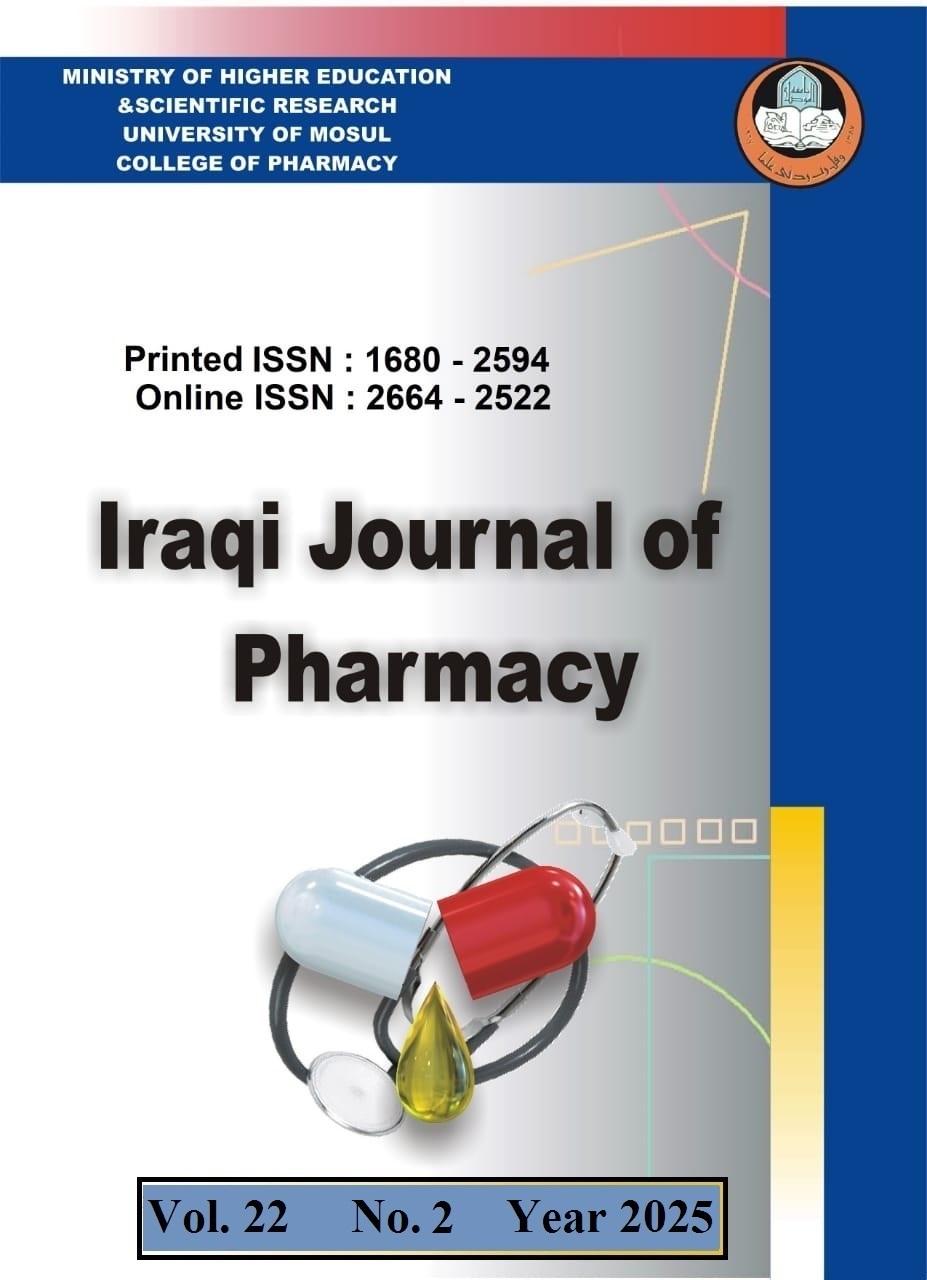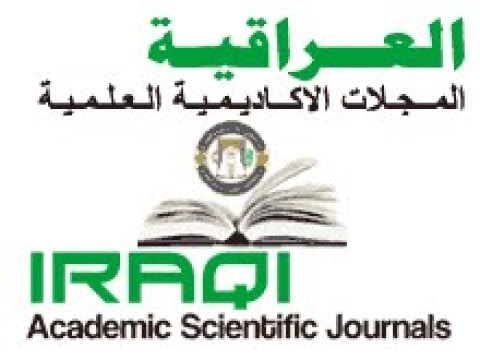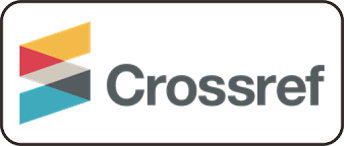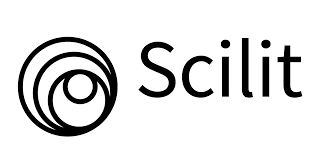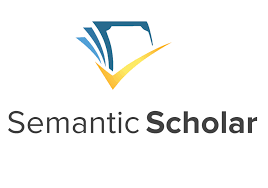Effects of Epigallocatechin-3-Gallate (EGCG) in Diabetes Mellitus as a DYRK1A inhibitor
Abstract
Background: Diabetes mellitus is a common metabolic disorder characterized by chronic high blood sugar levels due to impaired insulin secretion or action. Existing diabetic medications have limitations, including high costs and the risk of hypoglycemia. Aim: To overcome these challenges, researchers are exploring advanced treatments, and one potential path is studying plants and natural sources. Many plants include green tea (Camellia sinensis), rich in catechin derivatives, particularly epigallocatechin-3-gallate (EGCG), have shown promising effect because this agent may enhance beta cell proliferation, so it can produce dramatic response in management of diabetes mellitus and it is expected to reduce complication of this disease. Thorough data searching from September 2021 to June 2023 was used to conduct this study. The key terms diabetes mellitus, herbal treatment of diabetes, DYRK1A inhibitor, Epigallocatechin-3-gallate, and beta cell proliferation were concomitantly searched in Google Scholar, Web of Science, and PubMed in order to find relevant material. The publications that are presented here were published between 2014 and 2023. Conclusion: Collectively EGCG properties as a DYRK1A inhibitor may enhance cell proliferation that is promising effects in diabetes mellitus treatment.
References
- Al Hroob AM, Abukhalil MH, Hussein OE, Mahmoud AM. Pathophysiological mechanisms of diabetic cardiomyopathy and the therapeutic potential of epigallocatechin-3-gallate. Biomedicine & Pharmacotherapy. 2019;109:2155-72.
- Aloo S-O, Ofosu FK, Kim N-H, Kilonzi SM, Oh D-H. Insights on Dietary Polyphenols as Agents against Metabolic Disorders: Obesity as a Target Disease. Antioxidants. 2023;12(2):416.
- Araldi GL, Hwang Y-W. Design, synthesis, and biological evaluation of polyphenol derivatives as DYRK1A inhibitors. The discovery of a potentially promising treatment for Multiple Sclerosis. Bioorganic & Medicinal Chemistry Letters. 2022;64:128675.
- Arista DM, Amelia R, Fitriani D, Khotimah H, Ratnaningrum SD, Irwanto Y, et al. Gestational Diabetes Mellitus: An overview and its potential treatment with herbs. GSC Biological and Pharmaceutical Sciences. 2023;23(3):261-73.
- Bain J, McLauchlan H, Elliott M, Cohen P. The specificities of protein kinase inhibitors: an update. Biochemical Journal. 2003;371(1):199-204.
- Bartosikova L, Necas J. Epigallocatechin gallate: A review. Veterinrn medicna. 2018;63(10):443-67.
- Barzowska A, Pucelik B, Pustelny K, Matsuda A, Martyniak A, Stpniewski J, et al. DYRK1A Kinase inhibitors promote -cell survival and insulin homeostasis. Cells. 2021;10(9):2263.
- Beyaz S, zlem G, Aslan A. The therapeutic effects and antioxidant properties of epigallocatechin-3 gallate: A new review. International Journal of Secondary Metabolite. 2022;9(2):125-36.
- Cai Z-Y, Li X-M, Liang J-P, Xiang L-P, Wang K-R, Shi Y-L, et al. Bioavailability of tea catechins and its improvement. Molecules. 2018;23(9):2346.
- Chaudhary P, Mitra D, Mohapatra PKD, Docea AO, Myo EM, Janmeda P, et al. Camellia sinensis: insights on its molecular mechanisms of action towards nutraceutical, anticancer potential and other therapeutic applications. Arabian Journal of Chemistry. 2023:104680.
- Chhetri D, Amarnath RN, Samal S, Palaniyandi K, Gnanasampanthapandian D. Diabetes Mellitus and iPSC-Based Therapy. Advances in Diabetes Research and Management: Springer; 2023. p. 225-46.
- Chinsembu KC. Diabetes mellitus and natures pharmacy of putative antidiabetic plants. Journal of herbal medicine. 2019;15:100230.
- Choi C, Han J, Son Y, Joo S, Kwon S, Lee Y-H. Green tea extract exhibits antidiabetic effects partly through regulating dipeptidyl peptidase-4 expression in adipose tissue. The Journal of Nutritional Biochemistry. 2023;111:109173.
- De la Torre R, De Sola S, Pons M, Duchon A, de Lagran MM, Farr M, et al. Epigallocatechin3gallate, a DYRK1A inhibitor, rescues cognitive deficits in D own syndrome mouse models and in humans. Molecular nutrition & food research. 2014;58(2):278-88.
- Dirice E, Walpita D, Vetere A, Meier BC, Kahraman S, Hu J, et al. Inhibition of DYRK1A stimulates human -cell proliferation. Diabetes. 2016;65(6):1660-71.
- Duchon A, Herault Y. DYRK1A, a dosage-sensitive gene involved in neurodevelopmental disorders, is a target for drug development in Down syndrome. Frontiers in behavioral neuroscience. 2016;10:104.
- Ferrari E, Bettuzzi S, Naponelli V. The Potential of Epigallocatechin Gallate (EGCG) in Targeting Autophagy for Cancer Treatment: A Narrative Review. Int J Mol Sci. 2022;23(11):6075.
- Golovinskaia O, Wang C-K. The hypoglycemic potential of phenolics from functional foods and their mechanisms. Food Science and Human Wellness. 2023;12(4):986-1007.
- Guo Y, Li L, Yao Y, Li H. Regeneration of Pancreatic -Cells for Diabetes Therapeutics by Natural DYRK1A Inhibitors. Metabolites. 2023;13(1):51.
- Hannan J, Nipa N, Toma FT, Talukder A, Ansari P. Acute Anti-Hyperglycaemic Activity of Five Traditional Medicinal Plants in High Fat Diet Induced Obese Rats. Frontiers in Bioscience-Scholar. 2023;15(2):5.
- Jamir A, Longkumer S, Pankaj PP. Epigallocatechin Gallate Improves Caudal Fin Regeneration in the Streptozotocin-Induced Diabetic Zebrafish Model. Journal of Pharmaceutical Negative Results. 2023:1264-70.
- Janabi AHW, Kamboh AA, Saeed M, Xiaoyu L, BiBi J, Majeed F, et al. Flavonoid-rich foods (FRF): A promising nutraceutical approach against lifespan-shortening diseases. Iranian Journal of Basic Medical Sciences. 2020;23(2):140.
- Karakose E, Ackeifi C, Wang P, Stewart AF. Advances in drug discovery for human beta cell regeneration. Diabetologia. 2018;61:1693-9.
- Kim Y-J, Kim K-S, Lim D, Yang DJ, Park J-I, Kim KW, et al. Epigallocatechin-3-gallate (EGCG)-inducible SMILE inhibits STAT3-mediated hepcidin gene expression. Antioxidants. 2020;9(6):514.
- Koonyosying P, Uthaipibull C, Fucharoen S, Koumoutsea EV, Porter JB, Srichairatanakool S. Decrement in cellular iron and reactive oxygen species, and improvement of insulin secretion in a pancreatic cell line using green tea extract. Pancreas. 2019;48(5):636.
- Kumar K, Suebsuwong C, Wang P, Garcia-Ocana A, Stewart AF, DeVita RJ. DYRK1A inhibitors as potential therapeutics for -cell regeneration for diabetes. Journal of Medicinal Chemistry. 2021;64(6):2901-22.
- Le P, Bui TC, Abramowitz J, Herman WH, Misra-Hebert AD, Rothberg MB. Trends in Use of High-Cost Antihyperglycemic Drugs Among US Adults with Type 2 Diabetes. Journal of General Internal Medicine. 2023;38(1):49-56.
- Li F, Liu R, Negi V, Yang P, Lee J, Jagannathan R, et al. VGLL4 and MENIN function as TEAD1 corepressors to block pancreatic cell proliferation. Cell reports. 2023;42(1).
- Li W, Zhu C, Liu T, Zhang W, Liu X, Li P, et al. Epigallocatechin-3-gallate ameliorates glucolipid metabolism and oxidative stress in type 2 diabetic rats. Diabetes and Vascular Disease Research. 2020;17(6):1479164120966998.
- Li X, Li S, Chen M, Wang J, Xie B, Sun Z. ()-Epigallocatechin-3-gallate (EGCG) inhibits starch digestion and improves glucose homeostasis through direct or indirect activation of PXR/CAR-mediated phase II metabolism in diabetic mice. Food & function. 2018;9(9):4651-63.
- Liu T, Wang Y, Wang J, Ren C, Chen H, Zhang J. DYRK1A inhibitors for disease therapy: Current status and perspectives. European journal of medicinal chemistry. 2021:114062.
- Malode LL, Manwar JV, Panchale WA, Bartere SA, Bakal RL. Potential of medicinal plants in management of diabetes: An updates. GSC Advanced Research and Reviews. 2021;8(1):149-59.
- Mariadoss AVA, Subramanian SA, Kwon Y-M, Shin S, Kim SJ. Epigallocatechin gallate protects the hydrogen peroxide-induced cytotoxicity and oxidative stress in tenocytes. Process Biochemistry. 2023.
- Matalqah SM, Al-Tawalbeh DM. Medicinal plants potential against diabetes mellitus. Diabetes. 2025;9(10):11.
- Messire G, Serreau R, Berteina-Raboin S. Antioxidant Effects of Catechins (EGCG), Andrographolide, and Curcuminoids Compounds for Skin Protection, Cosmetics, and Dermatological Uses: An Update. Antioxidants. 2023;12(7):1317.
- Min K-j, Kwon TK. Anticancer effects and molecular mechanisms of epigallocatechin-3-gallate. Integrative medicine research. 2014;3(1):16-24.
- Mittal A, Singh A, Benjakul S. -amylase inhibitory activity of chitooligosaccharide from shrimp shell chitosan and its epigallocatechin gallate conjugate: kinetics, fluorescence quenching and structureactivity relationship. Food Chemistry. 2023;403:134456.
- Mohammed A. Hypoglycemic Potential of African Medicinal Plants in Diabetic and Non-Diabetic Human Subjects: A Review. Clinical Complementary Medicine and Pharmacology. 2023:100081.
- Nagle DG, Ferreira D, Zhou Y-D. Epigallocatechin-3-gallate (EGCG): chemical and biomedical perspectives. Phytochemistry. 2006;67(17):1849-55.
- Ojetunde A. Antidiabetic effects of medicinal plants. 2021.
- Okaiyeto K, Kerebba N, Rautenbach F, Singh SK, Dua K, Oguntibeju OO. UPLC-ESI-QTOF-MS phenolic compounds identification and quantification from ethanolic extract of Myrtus communis Variegatha: In vitro antioxidant and antidiabetic potentials. Arabian Journal of Chemistry. 2023;16(2):104447.
- Ong KL, Stafford LK, McLaughlin SA, Boyko EJ, Vollset SE, Smith AE, et al. Global, regional, and national burden of diabetes from 1990 to 2021, with projections of prevalence to 2050: a systematic analysis for the Global Burden of Disease Study 2021. The Lancet. 2023.
- Ortega M, De Toma I, Fernndez-Blanco , Caldern Moruno A, Barahona L, Trulls R, et al. Proteomic profiling reveals mitochondrial dysfunction in the cerebellum of transgenic mice overexpressing DYRK1A, a Down syndrome candidate gene. Front Mol Neurosci 2022 Dec 15; 15: 1015220. 2022.
- Ortega S. The Role of Herbal Medicines in Central American Indigenous Communities; Improving Accessibility to Type 2 Diabetes Mellitus Treatment. 2023.
- Ou K, Zhang S, Song J, Fang L, Xia S, Huang J, et al. Prenatal EGCG consumption causes obesity and perturbs glucose homeostasis in adult mice. The Journal of Nutritional Biochemistry. 2023;111:109179.
- Patil S, Bahadure S, Patil S. Formulation of canagliflozin hemihydrate-loaded bilosomes for the treatment of Type-2 diabetes mellitus: In vitro, in vivo and in silico molecular docking studies. Journal of Drug Delivery Science and Technology. 2023:104630.
- Pavlovi MO, Staji M, Gai U, Duleti-Lauevi S, ilerdi J. The chemical profiling and assessment of antioxidative, antidiabetic and antineurodegenerative potential of Kombucha fermented Camellia sinensis, Coffea arabica and Ganoderma lucidum extracts. Food & Function. 2023;14(1):262-76.
- Pucelik B, Barzowska A, Czarna A. DYRK1A inhibitors leucettines and TGF- inhibitor additively stimulate insulin production in beta cells, organoids, and isolated mouse islets. Plos one. 2023;18(5):e0285208.
- Ramesh N, Mandal AKA. Pharmacokinetic, toxicokinetic, and bioavailability studies of epigallocatechin-3-gallate loaded solid lipid nanoparticle in rat model. Drug development and industrial pharmacy. 2019;45(9):1506-14.
- Sahadevan R, Singh S, Binoy A, Sadhukhan S. Chemico-biological aspects of ()-epigallocatechin-3-gallate (EGCG) to improve its stability, bioavailability and membrane permeability: Current status and future prospects. Critical Reviews in Food Science and Nutrition. 2022:1-30.
- Salmern-Manzano E, Garrido-Cardenas JA, Manzano-Agugliaro F. Worldwide research trends on medicinal plants. International journal of environmental research and public health. 2020;17(10):3376.
- Sang S, Lambert JD, Ho C-T, Yang CS. The chemistry and biotransformation of tea constituents. Pharmacological research. 2011;64(2):87-99.
- Shen W, Taylor B, Jin Q, Nguyen-Tran V, Meeusen S, Zhang Y-Q, et al. Inhibition of DYRK1A and GSK3B induces human -cell proliferation. Nature communications. 2015;6(1):8372.
- Song W-Y, Aihara Y, Hashimoto T, Kanazawa K, Mizuno M. ()-Epigallocatechin-3-gallate induces secretion of anorexigenic gut hormones. Journal of Clinical Biochemistry and Nutrition. 2015;57(2):164-9.
- Taheriazam A, Entezari M, Firouz ZM, Hajimazdarany S, Heydargoy MH, Moghadassi AHA, et al. Eco-friendly chitosan-based nanostructures in diabetes mellitus therapy: Promising bioplatforms with versatile therapeutic perspectives. Environmental Research. 2023:115912.
- Upputuri RTP, Kulandaivelu K, Mandal AKA. Nanotechnology-based approach for enhanced bioavailability and stability of tea polyphenolsa review. Studies in Natural Products Chemistry. 2016;50:399-410.
- Wal P, Singh P, Sinha A. A Detailed Review of Various Herbal Treatment Options for Potentially Curing or Ameliorating Pain in Diabetic Neuropathy. Current Traditional Medicine. 2023;9(2):1-18.
- Wang H. GRP94 is an IGF-1R Chaperone and Regulates Beta Cell Death in Diabetes. 2023.
- Wang L, Li P, Feng K. EGCG adjuvant chemotherapy: Current status and future perspectives. European Journal of Medicinal Chemistry. 2023:115197.
- Wang P, Alvarez-Perez J-C, Felsenfeld DP, Liu H, Sivendran S, Bender A, et al. A high-throughput chemical screen reveals that harmine-mediated inhibition of DYRK1A increases human pancreatic beta cell replication. Nature medicine. 2015;21(4):383-8.
- WANG P, KUMAR K, LIU H, WOOD O, KARAKOSE E, CHOLEVA L, et al. 349-OR: Selected DYRK1A Inhibitors Simultaneously Drive Both Human Beta-Cell Proliferation and Differentiation. Diabetes. 2023;72(Supplement_1).
- Xu H, Gan C, Xiang Z, Xiang T, Li J, Huang X, et al. Targeting the TNF-TNFR interaction with EGCG to block NF-B signaling in human synovial fibroblasts. Biomedicine & Pharmacotherapy. 2023;161:114575.
- Yang Y, Fan X, Liu Y, Ye D, Liu C, Yang H, et al. Function and Inhibition of DYRK1A: emerging roles of treating multiple human diseases. Biochemical Pharmacology. 2023:115521.
- Yedjou CG, Grigsby J, Mbemi A, Nelson D, Mildort B, Latinwo L, et al. The management of diabetes mellitus using medicinal plants and vitamins. International Journal of Molecular Sciences. 2023;24(10):9085.
- Zhou Y, Suo W, Zhang X, Yang Y, Zhao W, Li H, et al. Targeting epigenetics in diabetic cardiomyopathy: Therapeutic potential of flavonoids. Biomedicine & Pharmacotherapy. 2023;157:114025.
- Zhu T, Li M, Zhu M, Liu X, Huang K, Li W, et al. Epigallocatechin-3-gallate alleviates type 2 diabetes mellitus via -cell function improvement and insulin resistance reduction. Iranian Journal of Basic Medical Sciences. 2022;25(4):483.
- Zuhra K, Petrosino M, Gupta B, Panagaki T, Cecconi M, Myrianthopoulos V, et al. Epigallocatechin gallate is a potent inhibitor of cystathionine beta-synthase: Structure-activity relationship and mechanism of action. Nitric Oxide. 2022;128:12-24.
